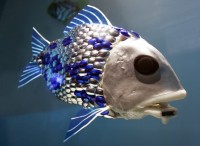SHOAL
G8 – pollution detecting robotic fish
source: designboom
the shoal european research project has developed robotic fish that work together to monitor pollution in harbors and other aquatic areas. the bright yellow robots are undergoing their first in-vivo trials in the port of gijon, spain.
traditional methods of monitoring pollution involve the collecting of water samples by human divers– generally about once a month– which are then tested in labs onshore. by contrast, using autonomous robots, data could be collected onsite and in realtime, offering quicker response in the event of pollution problems.
the fish are each about 5 feet (1.5 meters long), about the size and shape of a tuna. their motion has also been modeled
on that of real fish, relying on undulating motion instead of conventional propellers, and a dual-hinged tail to permits sharp turns.
micro-electrode arrays can detect lead, copper, and other pollutants, in addition to water salinity and oxygen levels.
battery-powered, the fish run for 8 hours on a single charge at a maximum speed of 1.1 yards (1 meter) per second, before being recovered by boat. safety features include a built-in airbag that inflates to make the fish surface in distress, with a GPS and cellphone chip built into the fin to send location details via text message. in addition, the fish communicate with one another, using low-frequency sound waves over a region of water up to about 11,000 square feet (1 kilometer square), to a depth of 98 feet (30 meters). in this way, a fish detecting pollution in one area can call upon the others to create a detailed map
of high and low concentrations around it, helping authorities determine the source of the pollutant.
the current model of robotic fish undergoes a short test submersion
in the future, developments should let the fish automatically return to charging stations, preventing the need for them to be collected and charged every 8 hours. researchers also note that the device’s modular design facilitates the switching out of chemical sensors to monitor specific contaminants in certain environments; alternatively, sensors and materials could be loaded towards other applications, providing different functions from search-and-rescue data to underwater photography.
the fish themselves are being built by professor huosheng hu and his team at the university of essex school of computer science and electronic engineering. shoal is a consortium of business and academic organizations managed by BMT group, funded by CORDIS, the european commission community research and development information service.
.
.
.
.
.
.
.
source: roboshoal
Shoal is a European Research Project Managed by BMT funded under the Seventh Framework Programme for ICT.
SHOAL aims to develop number of robotic fish that will work together in order to monitor and search for pollution in ports and other aquatic areas. Traditional methods of monitoring pollution involve getting samples in some way (divers) and then sending the samples back to the lab to be tested, the whole process takes time and makes real-time pollution information far from a reality. Shoal aims to make this process real-time. By having autonomously controlled fish with chemical sensors attached we aim to do these tests in-situ. Further to this the fish will also be given an intelligence so that if they do find significant amounts of pollution and they deduce it’s comming from a source they will all work together to find the source of the pollution so that the port can stop the problem early before more pollution occurs.
.
.
.
.
.
.
.
source: reuters
Robot fish developed by British scientists are to be released into the sea off north Spain to detect pollution.
If next year’s trial of the first five robotic fish in the northern Spanish port of Gijon is successful, the team hopes they will be used in rivers, lakes and seas across the world.
The carp-shaped robots, costing 20,000 pounds ($29,000) apiece, mimic the movement of real fish and are equipped with chemical sensors to sniff out potentially hazardous pollutants, such as leaks from vessels or underwater pipelines.
They will transmit the information back to shore using Wi-Fi technology.
Unlike earlier robotic fish, which needed remote controls, they will be able to navigate independently without any human interaction.
Rory Doyle, senior research scientist at engineering company BMT Group, which developed the robot fish with researchers at Essex University, said there were good reasons for making a fish-shaped robot, rather than a conventional mini-submarine.
“In using robotic fish we are building on a design created by hundreds of millions of years’ worth of evolution which is incredibly energy efficient,” he said.
“This efficiency is something we need to ensure that our pollution detection sensors can navigate in the underwater environment for hours on end.”
The robot fish will be 1.5 meters (nearly 5 feet) long — roughly the size of a seal.
.
.
.
.
.
.
source: muyinteresante
Sensores químicos incrustados en su cuerpo miden los niveles de oxígeno y detectan agentes contaminantes en el mar, datos que el mecanismo transmite vía WiFi al control en tierra. Incluso estos robots se comunican entre sí e intercambian datos de navegación mediante una especie de señal de sonar.
Estos robots-carpa fueron diseñados por investigadores británicos y forman parte del proyecto SHOAL, para monitorear los niveles de contaminación de las aguas de puertos y áreas acuáticas, financiado por la Unión Europea y de la empresa BMT.
Un primer punto ha sido el puerto de Musel, en Gijón, España, donde estos autómatas de hasta metro y medio de largo han nadado en aguas abiertas. Fueron creados mediante biomimética, a fin de confundir su movimiento con el de los peces reales. Se mueven por baterías eléctricas, de este modo navegan de manera autónoma (cuando están cerca de agotar sus reservas se dirigen a repostar) y no requieren de control remoto.
Es posible verlos como una de las principales atracciones del Museo de las Ciencias de Londres aquí, pero también en este video donde se presenta al G8 Robotic Fish.
.
.
.
.
.
.
source: origohu
Először készítettek olyan robothalat a kutatók, melyet a valódi halak fajtársukként kezeltek. A robot segítségével sikerült rávenni a halakat arra, hogy módosítsák az úszás irányát. A halrajok viselkedésének pontosabb megismerése segítséget jelenthet abban, hogy megjósolják, milyen hatással lesznek az emberi beavatkozások a halak populációira és azok vándorlására.
A Leedsi Egyetem kutatói a gipsztestű robothalat a tüskés pikóról (Gasterosteus aculeatus) mintázták meg, és Robofishnek nevezték el. Eleinte attól tartottak, hogy a szaga miatt a halak gyanút fognak, a csoport tagjainak felismerésében ugyanis nagyon fontos szerepet játszanak a szaganyagok. Ennek ellenére a számítógépes irányítású robotot a halak azonnal elfogadták, és úgy kezelték, mint egy valódi társukat.
A kutatók a robotot két különböző szituációban is kipróbálták, az első esetben egy magányos hal mellé tették be az akváriumba, míg a második esetben egy 10 tagú halraj mellé került. Mozgását úgy állították be, hogy egy átlagos halnál gyorsabban ússzon, és arra voltak kíváncsiak, hogy vajon a robothal rá tudja-e venni a többi halat arra, hogy a számukra idegen akváriumban kimerészkedjenek a számukra biztonságosnak tűnő rejtekhelyről.
A próba sikeres volt, a magányos hal a robothalhoz csatlakozva sokkal hamarabb elhagyta búvóhelyét, mintha egyedül indult volna felfedezni az akváriumot. A halraj esetében ennyire nem volt látványos a különbség, ők maguktól is viszonylag hamar előmerészkedtek. A kutatók a robothal segítségével arra is megpróbálták rávenni a többieket, hogy elkanyarodjanak, és ez mind a magányos hal, mind a csapat esetében sikerült. Ugyanakkor minél több időt töltöttek el az akváriumban a halak, annál bátrabbak lettek, és egyre kevésbé követték a valódi társaikat vagy a robotot.
.
.
.
.
.
.
.
source: gigamen
欧州を拠点とする研究プロジェクト・SHOALは、「ロボティック・フィッシュ(Robotic Fish)」の実用化の一歩を踏み出した。港湾の汚染状況を監視するための魚型ロボットは実験室を飛び出して、海中での試運転を行なった。販売予定価格は3万1600ドルのロボット、実用化は秒読み段階に。
ロボティック・フィッシュの目標は、水中汚染の探知であり、その把握に費やす時間の短縮だ。事前のデータ入力抜きで稼動し、数多くのセンサーを装備している。集めたデータは800メートル先の拠点まで送信することができる。
ロボットを魚型にする意味は、環境に溶け込ませるためであり、小さな範囲での調査のため。そんなロボットには人工知能が搭載されていて、海中に障害物があっても問題ない。もしロボットのバッテリーが切れかかると、拠点に戻ってくる仕組みにもなっている。バッテリーは1回の充電で8時間使用することが可能だ。
約150センチのロボットの水中での動きは不気味だ。そんな見た目はともかく、ロボティック・フィッシュの今後の可能性は無限大だ。水中の安全確保以外にも、捜索・救出活動の力になれるはず。今後搭載される機能次第では、放射能汚染の懸念もある日本の海洋調査の役にも立てるかもしれない。
.
.
.
.
.
.
.
source: cikaveorgua
Група наукових працівників з університету Ессекса (місто Колчестер, Велика Британія), створила рибу-робота (robotic fish), під назвою G8. Над цим проектом фахівці працювали вже досить давно. Це не є перша модель риби-робота, а вже восьме покоління.
Як заявляють розробники, ця унікальна риба-робот зможе глибоко занурюватися та досліджувати морські глибини і виявляти забруднення в морських портах. Для того, щоб вона могла оцінити рівень забрудненості, розробники обладнали її спеціальними сенсорами.
За допомогою Wi-Fi зв’язку, яким оснащена риба-робот, вона зможе передавати на станцію отримані дані. А за допомогою GPS, робот зможе самостійно повернутися на станцію.
З вигляду, риба-робот дуже схожа на справжнього коропа. На відміну від попередніх поколінь, володіє дуже природніми рухами, які можна побачити на відео:
Тіло: величина G8 дорівнює 50 см в довжину, 15 см у висоту, і 12 см в ширину. Дана модель зможе розвивати максимальну швидкість до 1,8 км / год.
Інші учені вже встигли виявити основні недоліки G8:
1) Ціна. Приблизна вартість – $ 30 000;
2) Тривалість роботи. G8 працює від підзарядки до 8 годин. Як вважають експерти, цього недостатньо, якщо проводити широкомасштабні досліди у світовому океані.
.
.
.
.
.
.
.
source: health20kr
해양오염을 탐지하는 로봇 물고기가 개발되어 화제입니다. 크기는 1.5m 정도이고 제작하는데 $3만 달러 정도가 소요되는 비싼 로봇입니다. 한번 충전이 되면 8시간을 움직일 수 있는데, 알아서 충전 스테이션으로 돌아와서 충전하고 다시 나간다고 합니다.
어떻게 생각하십니까? 8시간 정도 물속을 다닐 수 있다고 하는데, 그 정도로는 그리 효과적이지 못할 것 같습니다. 훨씬 가격이 싸고 오랫동안 다닐 수 있는 로봇이라면 모르겠지만, 8시간 정도 돌아다니기 위해 이렇게 비싼 로봇을 많이 이용해야 한다는 것은 낭비가 아닌지 …
.
.
.
.
.
.
source: freshgadgetsnl
Onderzoekers van de Universiteit van Essex hebben een interessante robot uitgevonden. Het is een vis die volledig computergestuurd de oceanen af kan struinen.
Een stel van de vissen wordt aan de noordkust van Spanje te water gelaten om daar giftige stoffen in het water te kunnen ontdekken. De vis is zo’n 2,5 meter lang en zwemt op het eigen navigatiesysteem met een snelheid van 3,5 kilometer per uur. Als de batterij leeg is zwemt de vis zelf terug naar zijn oplader. Een duur grapje is het wel: per vis wordt zo’n 30.000 dollar betaald.


